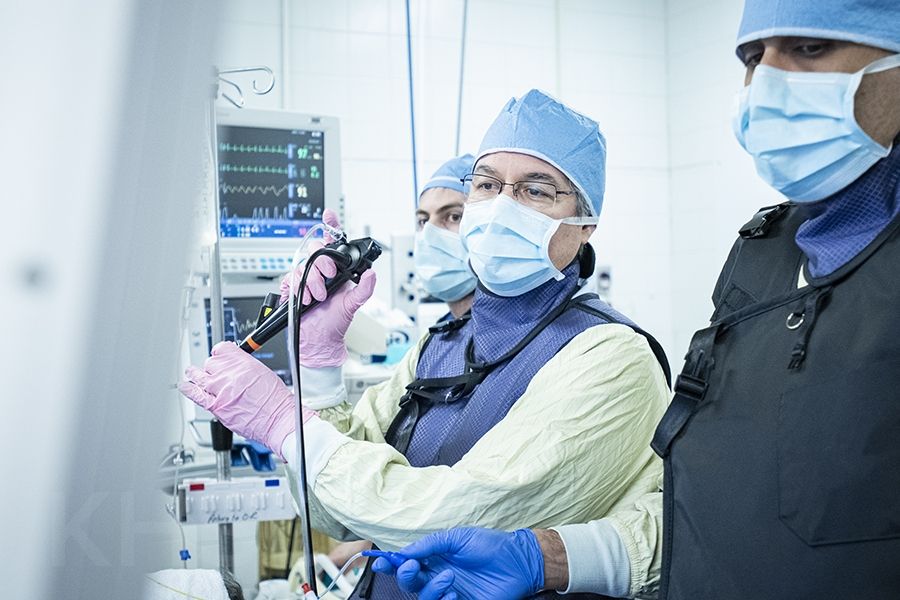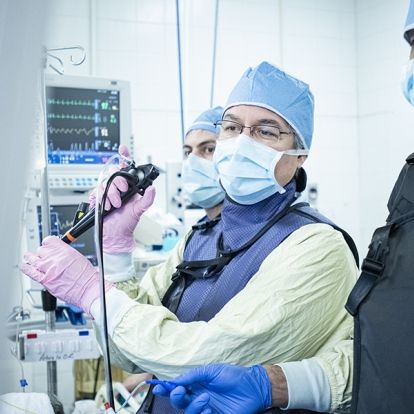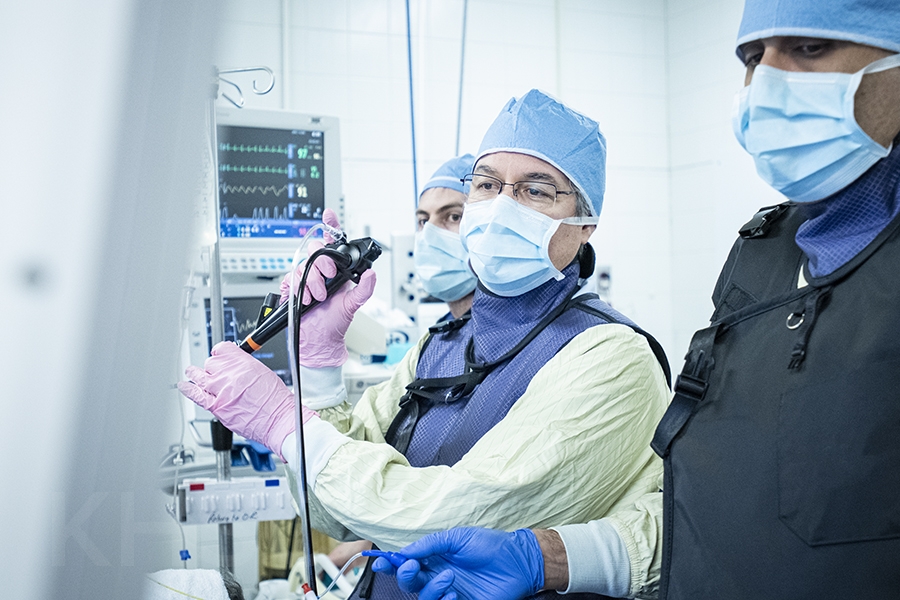Effective immediately masking is required for everyone when present on all inpatient units, in the Emergency Department (ED), the Urgent Care Centre (UCC), and the Children’s Outpatient Centre (COPC).

Without knowing which type of lung disease is causing a person’s shortness of breath, it is difficult to treat their symptoms and address possible causes. A lung biopsy is often the only way to determine the type of interstitial lung disease (ILD) a person has. ILD is a group of more than 200 lung conditions that thicken the interstitium, the space between the air sacs in the lung, making it difficult for oxygen to enter the bloodstream and for people to breathe.
In October 2018, Kingston Health Sciences Centre (KHSC) added a novel, less-invasive technique called transbronchial lung cryobiopsy, which under deep sedation uses a very cold probe inserted through a bronchoscope (a tube that is inserted through the mouth and into the main airways) to remove samples of lung tissue for ILD diagnosis. Since then, 15 patients have received this timely, innovative approach, thanks to a generous donation from the W.J. Henderson Foundation through Mr. David Pattenden, which made the purchase of specialized equipment possible.
Dr. Onofre Moran, a respirologist at KHSC and director of the Interstitial Lung Disease Program at Queen’s University, says he is very pleased with the results of the 15 cryobiopsies performed to date. “In 75 per cent of cases, the multidisciplinary team made up of respirologists, lung pathologists and chest radiologists, to name a few, were able to determine a plan for managing diseases without the need for lung surgery to obtain biopsies,” said Dr. Moran. “This is consistent with the findings from several of the largest multicentric cryobiopsy studies conducted to date.”
In addition to a quick recovery from the procedure for patients, who usually go home the same day, lung cryobiopsy can reduce diagnostic wait times for people. It is cost-effective because patients spend less time in hospital and require fewer hospital resources, and the procedure takes less time to perform. This results in more patient-centred care and better health-care value as compared with conventional open lung biopsy. The mortality rate associated with open lung biopsies is approximately 2 per cent and just 0.3 per cent for cryobiopsy.
“Other important benefits of lung cryobiopsy are larger tissue samples taken from multiple areas of the lungs and samples that have their natural architecture intact,” said Dr. Moran. “By not using the usual biopsy forceps through conventional bronchoscopy that squishes the sample, the cold probe is able to remove tissue without crushing it, which is important when pathologists need to examine lung tissue to make a diagnosis.”
The regular breathing in of small particles such as mold, and grain and metal dust can be a cause of interstitial lung disease in susceptible people. As well, rheumatic or autoimmune diseases may affect the interstitium. It’s rare, but some medications can cause ILD.
The cause of many types of ILD is unknown. Dr. Moran explains that “the most common interstitial lung disease with an unknown cause, idiopathic pulmonary fibrosis, is a progressive and fatal disease, with a worse prognosis than many cancers, including breast, colon and prostate cancer; however, if diagnosed early we can treat the disease with medications that can slow down the progression of the disease and prolong life.”
“We are grateful for the leadership and dedication that Dr. Moran has shown in bringing the option of lung cryobiopsy to KHSC patients with interstitial lung disease,” said Dr. Michael Fitzpatrick, KHSC’s Chief of Staff. “This is a really meaningful example of the innovation for which KHSC is known, and we are proud of our physicians and staff who embrace new diagnostic and treatment techniques to enhance the care we provide to the communities that we serve.”
Dr. Moran learned to perform transbronchial lung cryobiopies with Dr. Venerino Poletti in Italy and with Dr. Mordechai Kramer in Israel, whose centres have completed over 800 such cases each over the last decade.
“Learning from Dr. Poletti and Dr. Kramer’s experiences has helped us gain the expertise and implement the protocols needed to effectively manage or prevent complications such as bleeding and collapse of the lung,” said Dr. Moran. “Not only do I think I’ve learned from the best by working with my European colleagues; as far as I know, KHSC may now be the only Canadian teaching hospital outside of Quebec performing cryobiospies.”
Gallery


Middle: Dr. Onofre Moran, a respirologist at KHSC and director of the Interstitial Lung Disease Program at Queen’s University, performing a cryobiopsy, a technique he introduced to KHSC to help diagnose certain lung disease.



